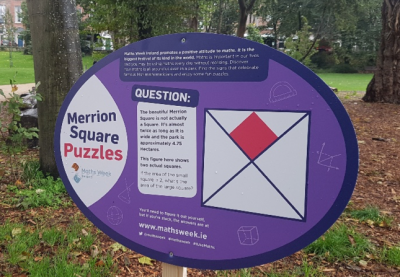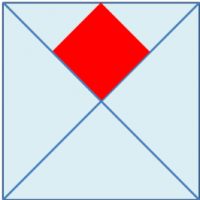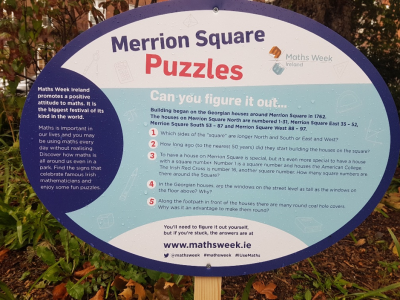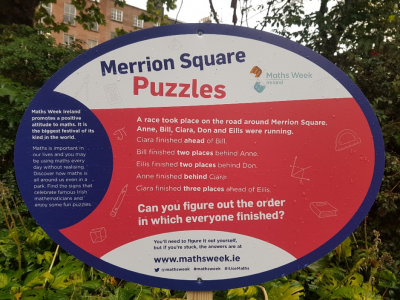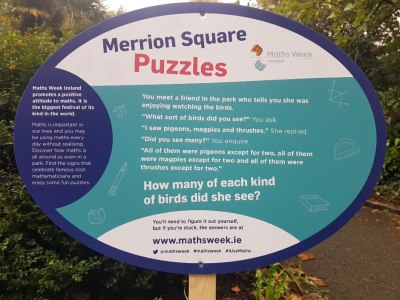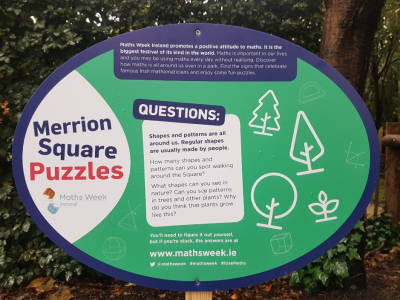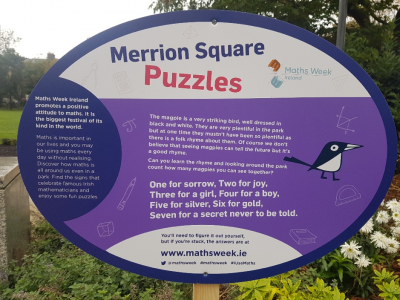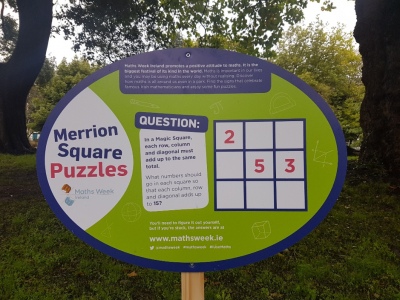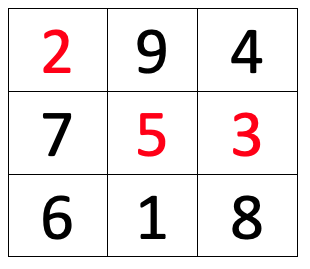Merrion Square Puzzles and Solutions
A Square Square?
Merrion Square is not actually a Square. It is almost twice as long as it is wide and the park is approximately 4.75 Hectares.
The figure shows two actual squares. If the area of the small square is 2, what is the area of the large square?
Solution: 16
This question can be done by trigonometry, but it can be solved in a simpler way by observing carefully and seeing where the symmetry is.
It should be observed that the small triangles either side of the red square are half the area of the square. That is if we flipped one and slid them both they would occupy the same area at the red square. That means the area of the big triangle Is 4. There are four of these so overall area is 16.
(by the way, we don’t give specific units in the question)
Square Numbers
Building began on the Georgian houses on Merrion Square in 1762. The houses on Merrion Square North are numbered 1-31, Merrion Square East 35 – 52, Merrion Square South 53 – 87 and Merrion Square West 88 – 97.
1) Which sides of the “square” are longest North and South or East and West?
The North and South sides are almost twice as long as the East and West sides.
2) How long ago (to the nearest 50 years) did they start building the houses on the square?
Around 250 years ago.
3) To have a house on Merrion Square is special, but it is more special to have a house with a square number. Number 1 is a square number and houses the American College, the Irish Red Cross is number 16, another square number. How many square numbers are there in all around the Square?
Nine house numbers are square numbers: 1, 4, 9, 16, 25, 36, 49, 64, 81.
4) How many houses on the Square do you think were demolished to build the National Maternity Hospital?
Three. The house numbers go up to 31 before the hospital and resume at 35 after the hospital. Therefore 32,33 and 34 are missing.
5) In the Georgian houses are the windows on the street level as tall as the windows on the floor above? Why?
The houses generally had their biggest room running across the front on the first floor. This is where they might be in the evenings and for entertaining. There would be more light in the evenings on the first floor that the ground floor and tall windows allowed more light in. In addition it probably looked more impressive to have tall windows.
While it is obvious from a distance, as from the park, that the first floor windows are taller than the street level windows, when one is on the footpath looking up it doesn’t appear so obvious.
6) Along the footpath in front of the houses there are many round coalhole covers. Why was it an advantage to make them round?
One great advantage is that a round cover cannot fall into a round hole. Whereas a square cover can fall down into a square hole.
A Race took Place
A race took place on the road around Merrion Square. Anne, Bill, Ciara, Don and Eilis were running.
Ciara finished ahead of Bill.
Bill finished two places behind Anne
Eilis finished two places behind Don
Anne finished behind Ciara
Ciara finished three places ahead of Eilis
Can you figure out the order in which everyone finished?
Solution: 1. Ciara, 2. Don 3. Anne 4. Eilis 5. Bill
For the Birds
You meet a friend in the park who tells you she was enjoying watching the birds.
“What sort of birds did you see?” You ask.
“I saw pigeons, magpies and thrushes.” She replied.
“Did you see many?” You enquired.
“All of them were pigeons except for two, all of them were magpies except for two and all of them were thrushes except for two.”
Can you figure out how many of each birds did she see?
Solution: One of each
Shapes
Shapes and patterns are all around us. Regular shapes are usually man made.
How many shapes and patterns can you spot walking around the Square?
What shapes can you see in nature? Can you see patterns in trees and other plants? Why do you think that plants grow like this?
Solution: This is a question you have to find the answers for yourself. This is to encourage observation and investigation.
The magpie
The magpie is a very striking bird, well dressed in black and white. They are very plentiful in the park but at one time mustn’t have been so plentiful as there was a folk rhyme about them. Of course we don’t believe that seeing magpies can tell the future but it is a good rhyme. Can you learn the rhyme and count how many magpies you can see together?
One for sorrow, Two for joy,
Three for a girl, Four for a boy,
Five for silver, Six for gold,
Seven for a secret never to be told.
Solution: This is a question you have to find the answers for yourself. This is to encourage observation and investigation.

